Many believe that collecting Lincoln Pennies is the best avenue into the hobby. They cost almost nothing, and they are all over the place. But what is the value of a 1967 Penny, and how attainable is it?
The short answer is “very attainable.” There are tons of these coins in the lower and middle grades, and at these conditions, they are fairly cheap.
Based on our analysis of the latest market data, a circulated 1967 Penny is worth about five cents. The About Uncirculated 1967 Pennies are worth between five and ten cents, depending on their condition. To acquire 1967 Pennies in their mint state, you’ll need a budget that ranges from 10 cents to $3,500.
While there are tons of 1967 Pennies in MS60 condition, only a few gems have grades of MS68 and above. And while we’ll touch upon that later in the article, it’s best to reiterate the figures I just mentioned.
Below is a summary comparing the value of the two main varieties of the 1967 Lincoln Cent.
1967 Penny Valuation Chart
| Coin Condition | Estimated Value | |
| Regular Strike | Special Mint Set (SMS) | |
| Circulated
(G4 – XF40) |
$0.05 | $0.05 |
| About Uncirculated (AU50 – AU58+) | $0.05 – $0.10 | $0.05 – $0.08 |
| Uncirculated
(MS60 – MS64+) |
$0.10 – $10.00 | $0.17 – $10.00 |
| Brilliant Uncirculated (MS65 or higher) | $2.50 -$175 | $8 – $3,500 |
1967 Penny: Historical Background
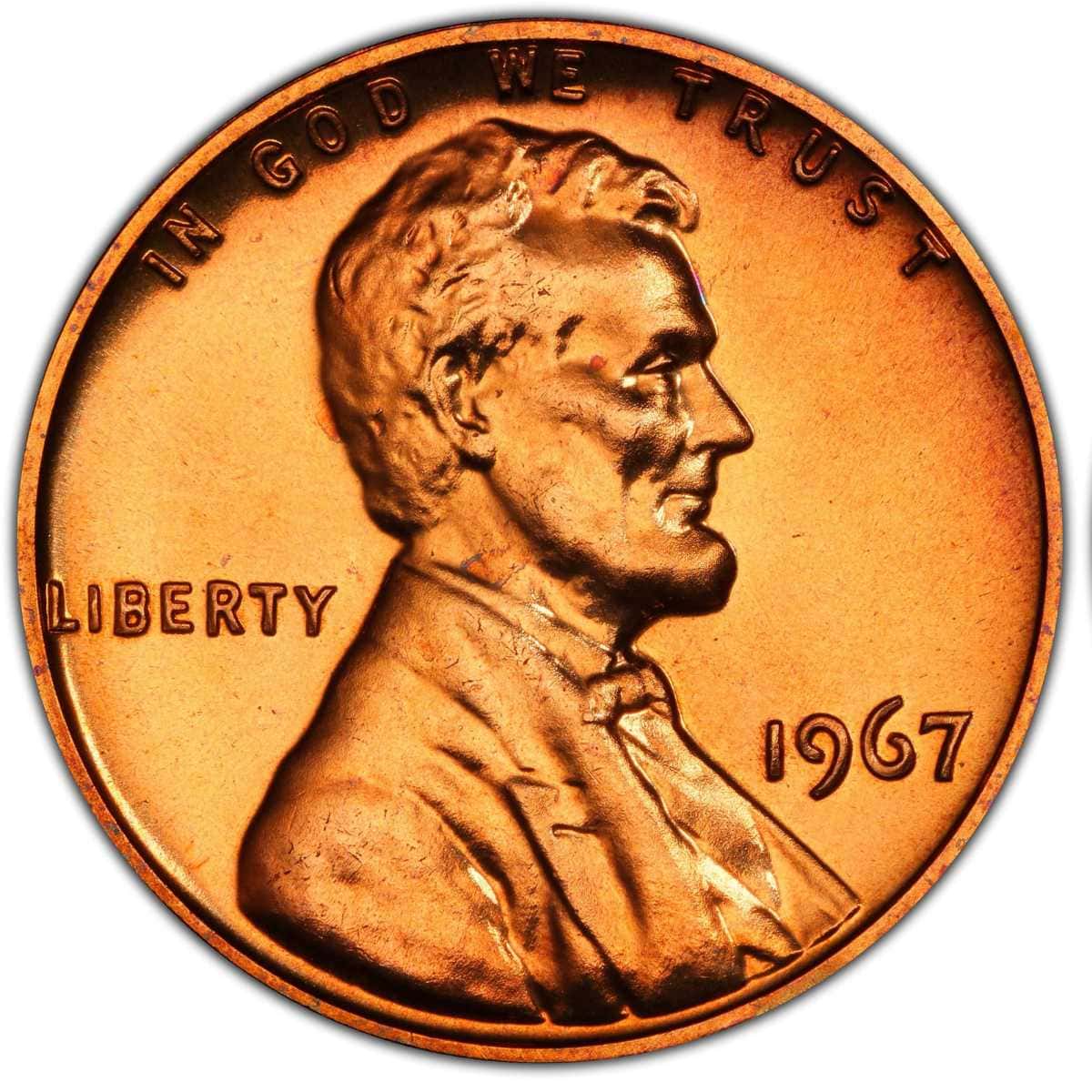
The 1967 Penny is different from your typical U.S. coinage in many ways. None of the pennies in this family bear any mint marks. And to understand why, I must explain the events that led to the production of the 1967 Lincoln Penny.
The 1960s were a golden era in the hobby. Many people were getting into coin collecting, and for the first time, it was an acceptable way for someone to spend their extra time and money. In the mid-’60s, the U.S. also suffered an acute coin shortage. While these events weren’t directly correlated, the government had its suspicions of hoarding among coin collectors.
Eventually, the government had to step in. And while there were attempts to outlaw coin collecting, our legislators went with the more diplomatic Coinage Act of 1965. While this new law removed silver content from the Dime and Quarter Dollar, it halted proof coin production for the next few years.
The U.S. Mint instead went with a Special Mint Set (or SMS), a family of coins endowed with a satin finish. These coins demanded less in terms of planchet preparation, allowing the U.S. Mint to concentrate its efforts elsewhere.
The new law also recommended the omission of mint marks, which was meant to discourage coin hoarding.
Were these changes to the minting process effective? It’s hard to tell. What we can report is that regular coinage resumed in 1968, with the San Francisco Mint concentrating on proof coin production.
1967 Penny: Physical Features
The Coinage Act of 1965 may not have altered the metallic composition of the Lincoln Memorial Penny, but it did alter the appearance of some 1967 Pennies.
The regular strikes were in the usual Red, Red-Brown, and Brown varieties, while the 1967 Special Mint Sets featured a more refined satin finish. They may not look as refined as proof coins, but they definitely have superior eye appeal over the regular strikes. Cameo versions of these coins also exist.
Coin: Physical Characteristics
| Physical Feature | Notes |
| Color | Bronze, Red
Bronze, Red-Brown Bronze, Brown |
| Metallic Composition | 95% Copper
5% Zinc & Tin |
| Weight | 3.11 grams |
| Diameter | 19.00 mm |
| Edge | Plain |
Obverse Design and Features
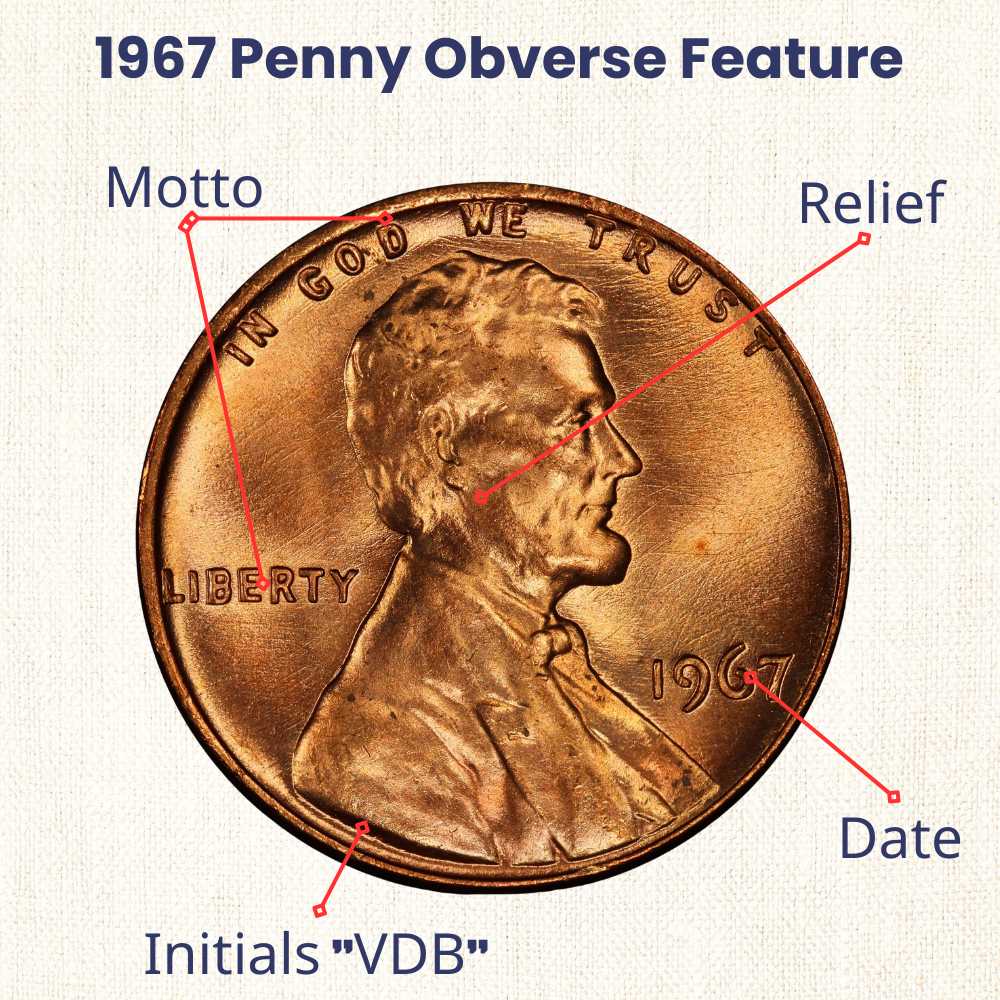
While the edge of the 1967 Penny is plain, its faces are decorated with intricate details of high complexity. For the obverse, the U.S. Mint went with the design that graced the very first Lincoln Penny in 1909. I’m talking about the Victor D. Brenner design that is still used on the Lincoln Memorial Penny today.
The obverse of the 1967 Lincoln Memorial Cent features the following elements:
- The right-facing profile of President Abraham Lincoln
- The legend “IN GOD WE TRUST.”
- The inscription “LIBERTY”
- The date “1967”
- The designer’s initials, “VDB” (for Victor David Brenner)
Reverse Design and Features
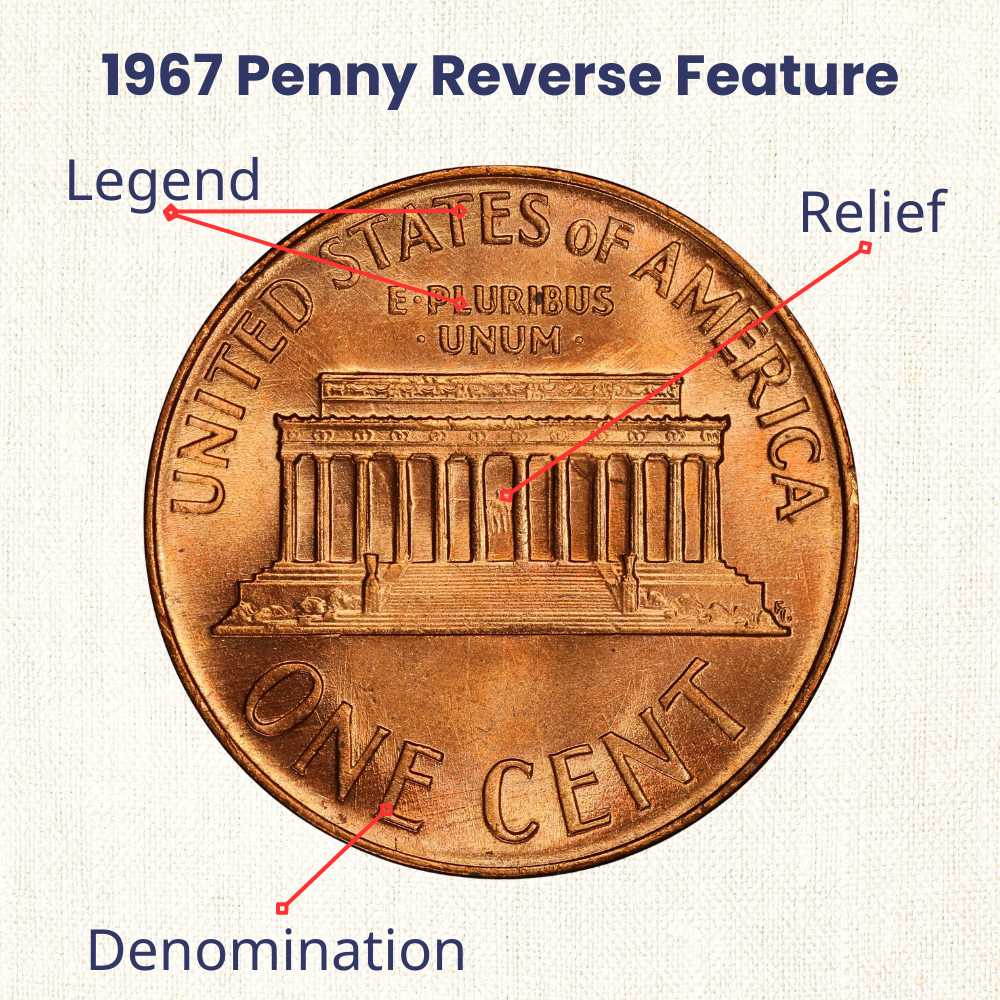
To mark the Sesquicentennial of President Lincoln’s birth, the U.S. Mint overhauled the reverse of the Lincoln Penny back in 1959. They did away with Victor Brenner’s Wheat Reverse and installed Frank Gasparro’s Lincoln Memorial Reverse.
The 1967 Penny bears the Lincoln Memorial reverse, which features the following articles:
- A front-facing depiction of the Lincoln Memorial
- The country of issue “UNITED STATES OF AMERICA”
- The inscription “E PLURIBUS UNUM”
- The denomination “ONE CENT”
- The designer’s initials “FG” (for Frank Gasparro)
1967 Penny: Varieties
The 1967 Penny may not come with as many varieties as other pennies, but the few we got are still very interesting. Join us as we discuss the value of these varieties.
1967 Penny Regular Strike Value
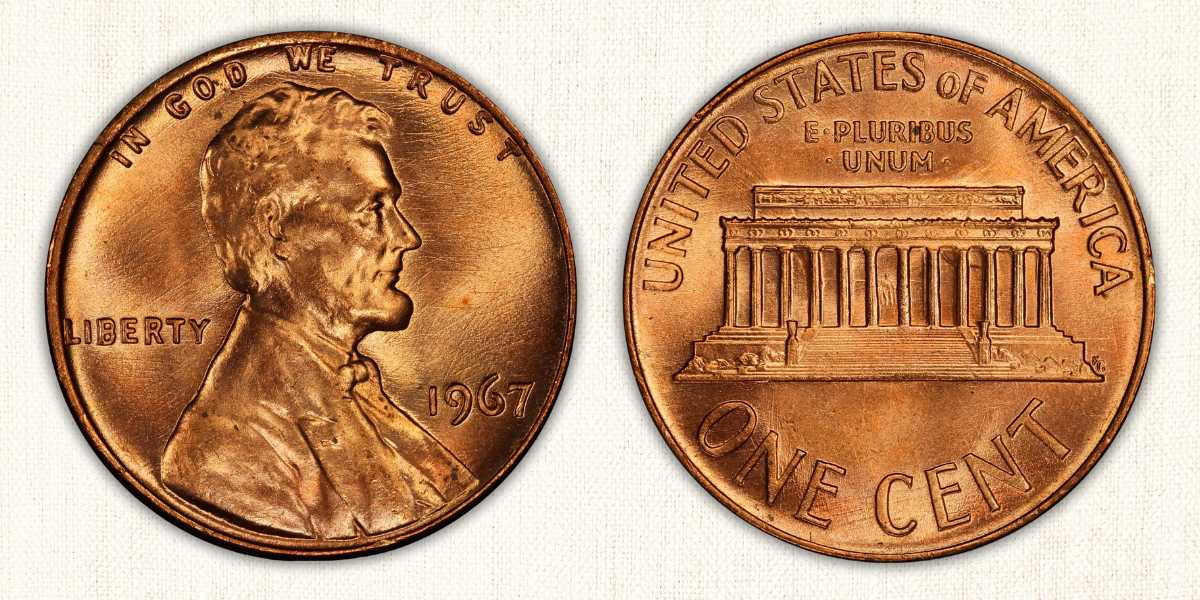
- U.S. Mint: Philadelphia, Denver, and San Francisco Mints
- Mintage: 3,048,667,100
- Mint Mark: None
With no mint marks to refer to, it’s nearly impossible to tell where a particular coin was minted. The word on the street is that the Philadelphia, Denver, and San Francisco Mints all took part in striking regular 1967 Pennies. To what extent was their contribution? We don’t know; your guess might just be as good as ours.
Brown pennies in this variety are the most abundant. They enjoyed heavy circulation over the decades, and you might even find a few examples among your change. So, how much value do they hold?
According to our analysis, circulated and about-circulated Brown 1967 Pennies are worth five cents, regardless of their condition. In their mint state, Brown 1967 Pennies have values that range between 10 cents and $12.50.
A vast majority of Red and Red-Brown 1967 Pennies will be in mint condition. The market is more favorable to Red pennies as they are the most valuable sub-variety.
NGC estimates the value of mint Red 1967 Pennies to be between $5 and $175, depending on their condition. Uncirculated Red-Brown 1967 Pennies are worth between $2.50 and $15.
If we were to compare the values of similarly-graded 1967 Pennies of each sub-variety, we would end up with the table below:
| Coin Condition | Estimated Value | ||
| Brown
(BN) |
Red-Brown
(RB) |
Red
(RD) |
|
| Good (G4) | $0.05 | – | – |
| Very Good (VG8) | $0.05 | – | – |
| Fine (F12) | $0.05 | – | – |
| Very Fine (VF20) | $0.05 | – | – |
| Extremely Fine (XF40) | $0.05 | – | – |
| About Uncirculated (AU50) | $0.05 | – | – |
| About Uncirculated (AU58) | $0.05 | – | – |
| Uncirculated (MS60) | $0.10 | – | – |
| Uncirculated (MS63) | $0.75 | $2.50 | $5 |
| Brilliant Uncirculated (MS65) | $2.50 | $10 | $15 |
| Brilliant Uncirculated (MS66) | $12.50 | $15 | $20 |
| Brilliant Uncirculated (MS67) | – | – | $175 |
There’s something important I have to mention: the figures in the table above are only estimates compiled by NGC based on their experience. The final selling price of a coin is reliant on its demand, which can fluctuate in an instant.
So, to get a full picture of what these pennies actually sell for, I found a list of high-profile auctions from the internet. Below are four notable auctions involving the 1967 Penny:
| Variety | Grade | Sales Price | Auction Firm |
| Red | MS67RD | $4,025 | Heritage Auctions |
| Red | MS67RD | $2,695 | Great Collections |
| Red | MS67RD | $2,350 | Heritage Auctions |
| Red | MS67RD | $998.75 | Heritage Auctions |
1967 Penny Special Strike Value
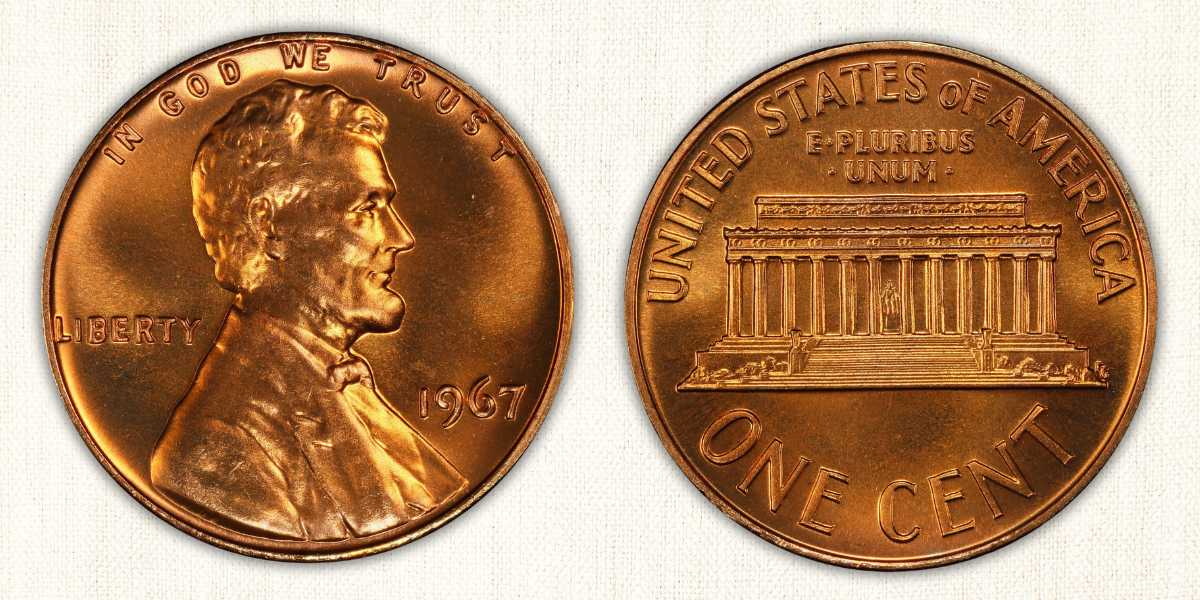
- U.S. Mint: San Francisco
- Mintage: 1,863,344
- Mint Mark: None
Breaking away from the tradition of striking proof coins, the U.S. Mint settles for Special Mint Sets endowed with a satin finish. While they don’t look like proof coins, the SMS 1967 Penny is still remarkably beautiful.
Their satin finish is their distinguishing feature. Yes, we get it: the SMS 1967 is a beautiful coin. But what is it worth?
The San Francisco Mint made the special mint set in Red, Brown, and Red-Brown varieties. All of them had a satin finish, and they looked spectacular. But the San Francisco facility also made a few Red pennies with cameo (the contrast between the mirror-like field and the frosted relief).
Cameo 1967 Pennies are by far the most desirable, with values that range between $215 and $3,500. The Red 1967 Pennies with a satin finish are valued between $10 and $190, in mint condition. The Red-Brown Pennies also exist in mint condition, and they are worth between $5 and $50.
The Brown 1967 Pennies with satin finishes have enjoyed decades of circulation. Remember, the existence of this coin was plotted in the Coinage Act of 1965, and it was meant to discourage coin collecting.
Brown SMS 1967 Pennies are valued at five cents in circulated condition. Its About Uncirculated counterparts are worth values in the neighborhood of seven cents. In mint condition, NGC values these coins at between $0.17 and $20.
| Coin Condition | Estimated Value | |||
| Brown
(BN) |
Red-Brown
(RB) |
Red
(RD) |
Cameo
(RDCAM) |
|
| Good (G4) | $0.05 | – | – | – |
| Very Good (VG8) | $0.05 | – | – | – |
| Fine (F12) | $0.05 | – | – | – |
| Very Fine (VF20) | $0.05 | – | – | – |
| Extremely Fine (XF40) | $0.05 | – | – | – |
| About Uncirculated (AU50) | $0.07 | – | – | – |
| About Uncirculated (AU58) | $0.08 | – | – | – |
| Uncirculated (MS60) | $0.17 | – | – | – |
| Uncirculated (MS64) | $1.175 | $5 | $10 | – |
| Brilliant Uncirculated (MS65) | $8 | $16 | $25 | $215 |
| Brilliant Uncirculated (MS67) | $20 | $25 | $40 | $800 |
| Uncirculated (MS68) | – | $50 | $190 | $3,500 |
In the open market, the status quo remains. Cameo examples of the 1967 Penny dominate the notable sales list.
| Variety | Grade | Sales Price | Auction Firm |
| SMS, Red Cameo | SP68RD | $5,581.25 | Heritage Auctions |
| SMS, Red Cameo | SP65RD | $3,360 | Heritage Auctions |
| SMS, Red Cameo | SP67RD | $1,840 | Heritage Auctions |
| SMS, Red Cameo | SP67RD | $1,265 | Heritage Auctions |
1967 Penny: Valuable Error Coins
The 1967 Penny might not have the most varieties, but it does have some interesting error coins. Below are five valuable 1967 Penny error coins we found on the internet:
1967 Penny Struck 60% Off-Center: Selling for $179.99

Rare are the times when dies and planchets misalign. But when the misalignment is great, they yield some spectacular coins. Our penny here was struck 60% off-center, practically deforming the planchet in some areas. Only half of President Lincoln’s face is showing.
1967 Penny Struck Off-Center: Selling for $45
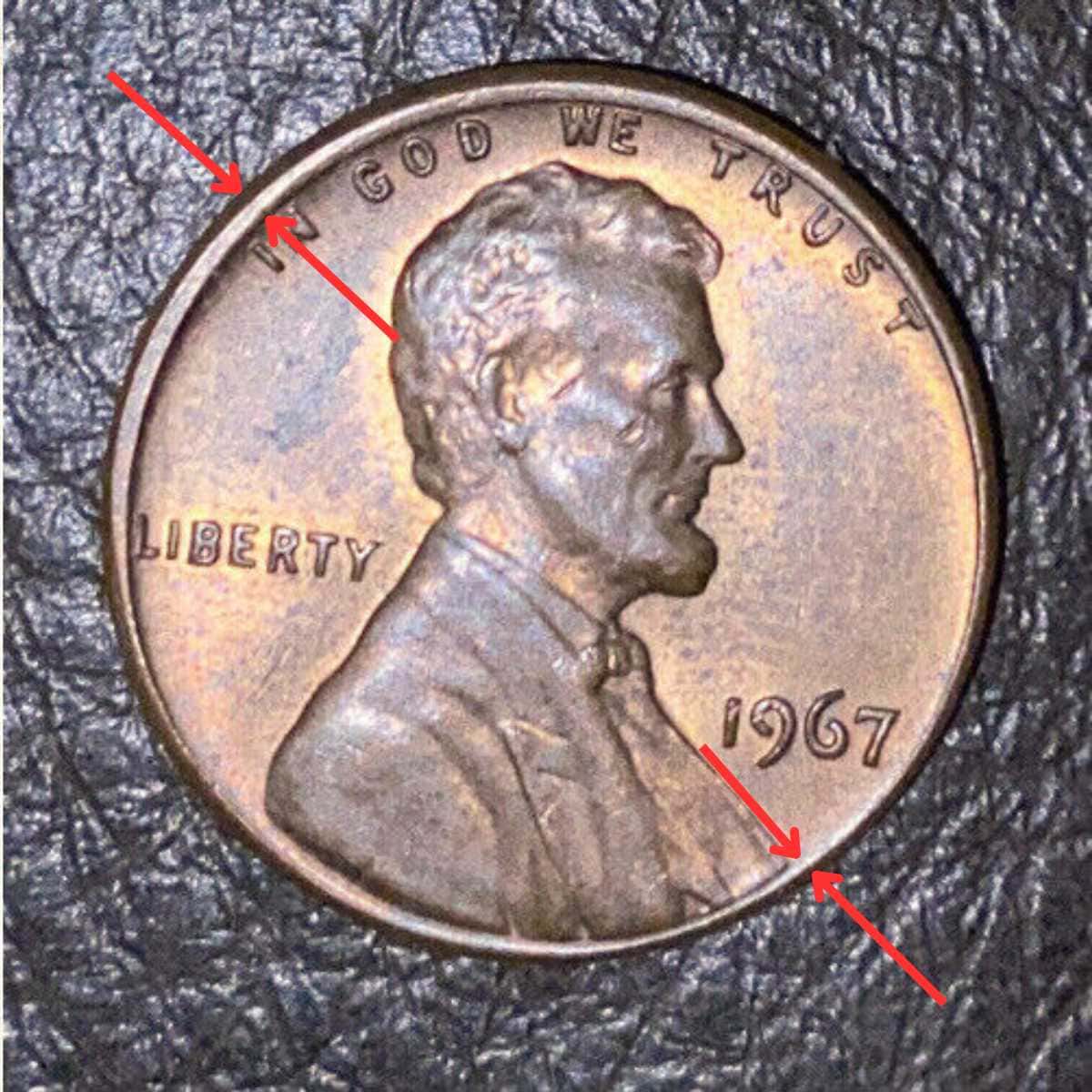
This coin may not be as spectacular as the last, but it still has an Off-center error. The penny’s rim on the obverse appears beefy in certain sections and non-existent in others. It feels like the obverse features were slightly shifted down towards the right.
1967 Penny struck Off-Center: Selling for $29.75
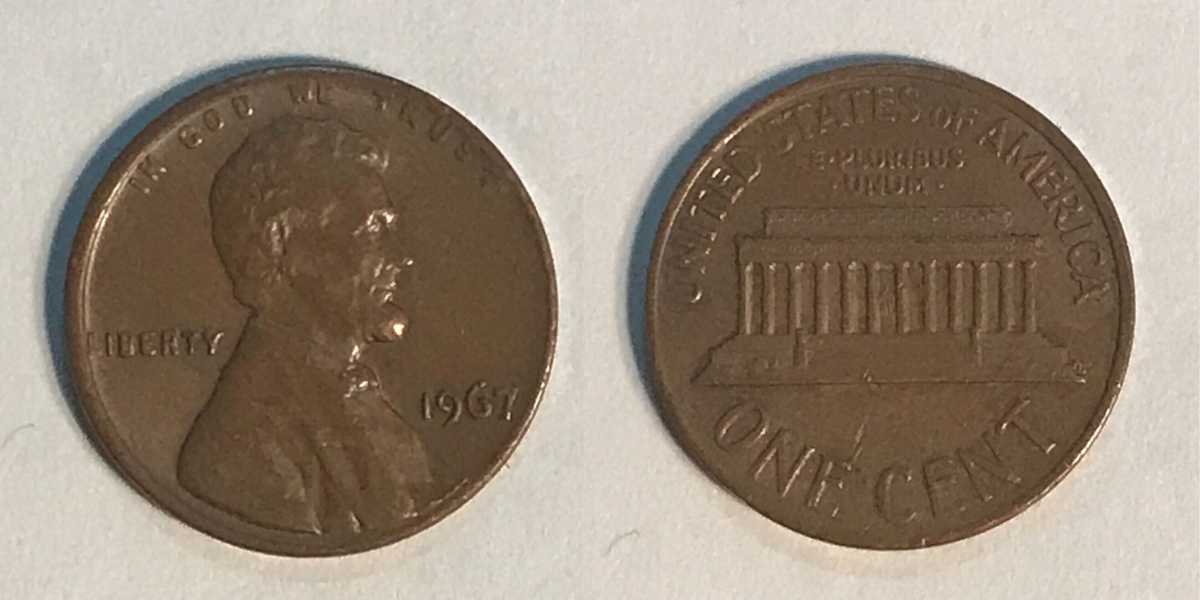
It’s starting to look like a good day for Off-Center error coin collectors. This coin may have also been struck slightly off-center, but it is in no condition near our last entrant. The coin has taken on a dull brown patina, suggestive of its About Uncirculated status.
1967 Penny with Double Date Error: Reserved at $9.99
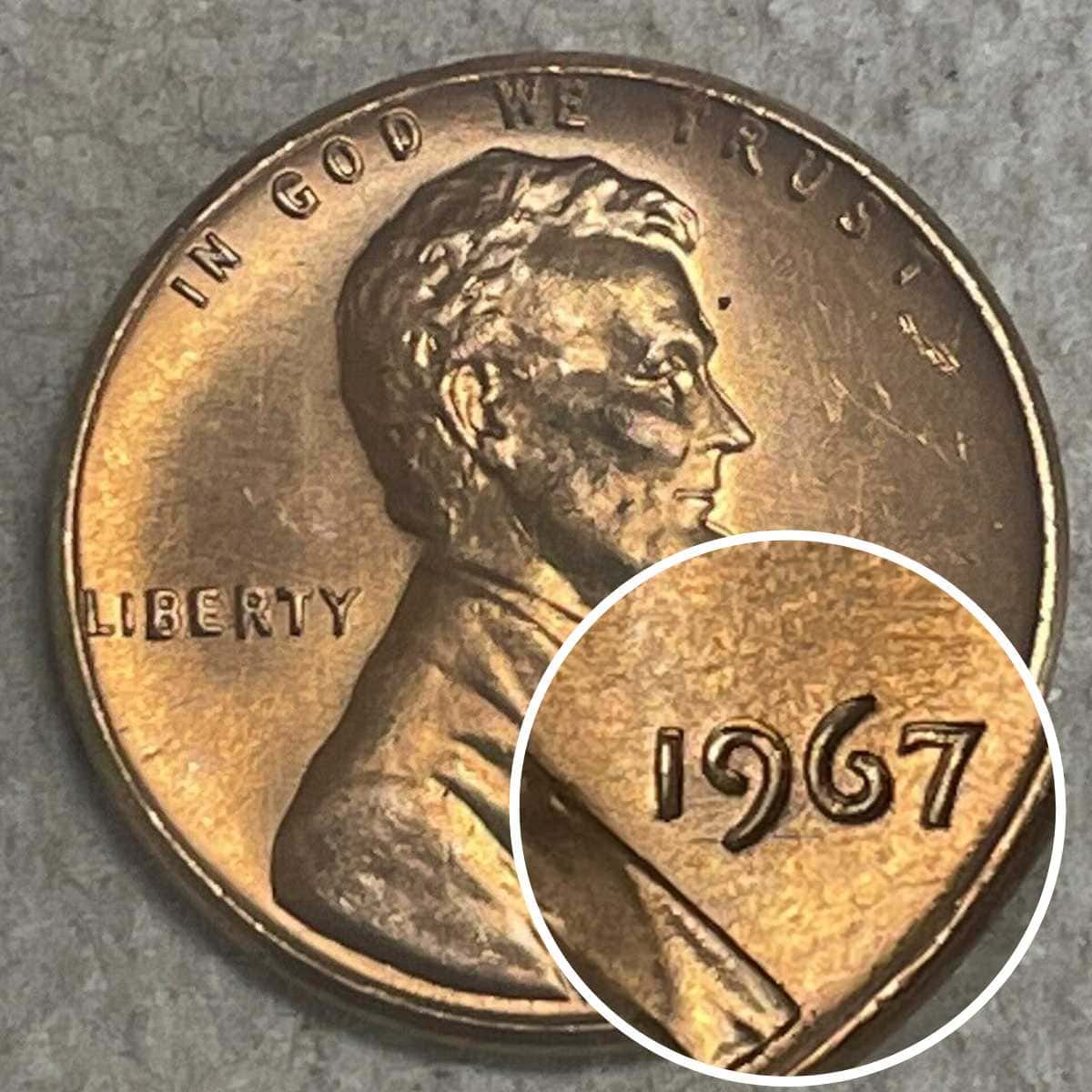
This coin is proof of what happens when a planchet falls out of alignment with the die between strikes. For this particular coin, the error is limited to the date, with visible doubling appearing around the edges of the numbers.
You don’t need an official grading to tell you that this coin is in mint condition. It also has a luster identical to a special strike with a satin finish.
1967 Penny with Clipped Planchet: Reserved at $2.00
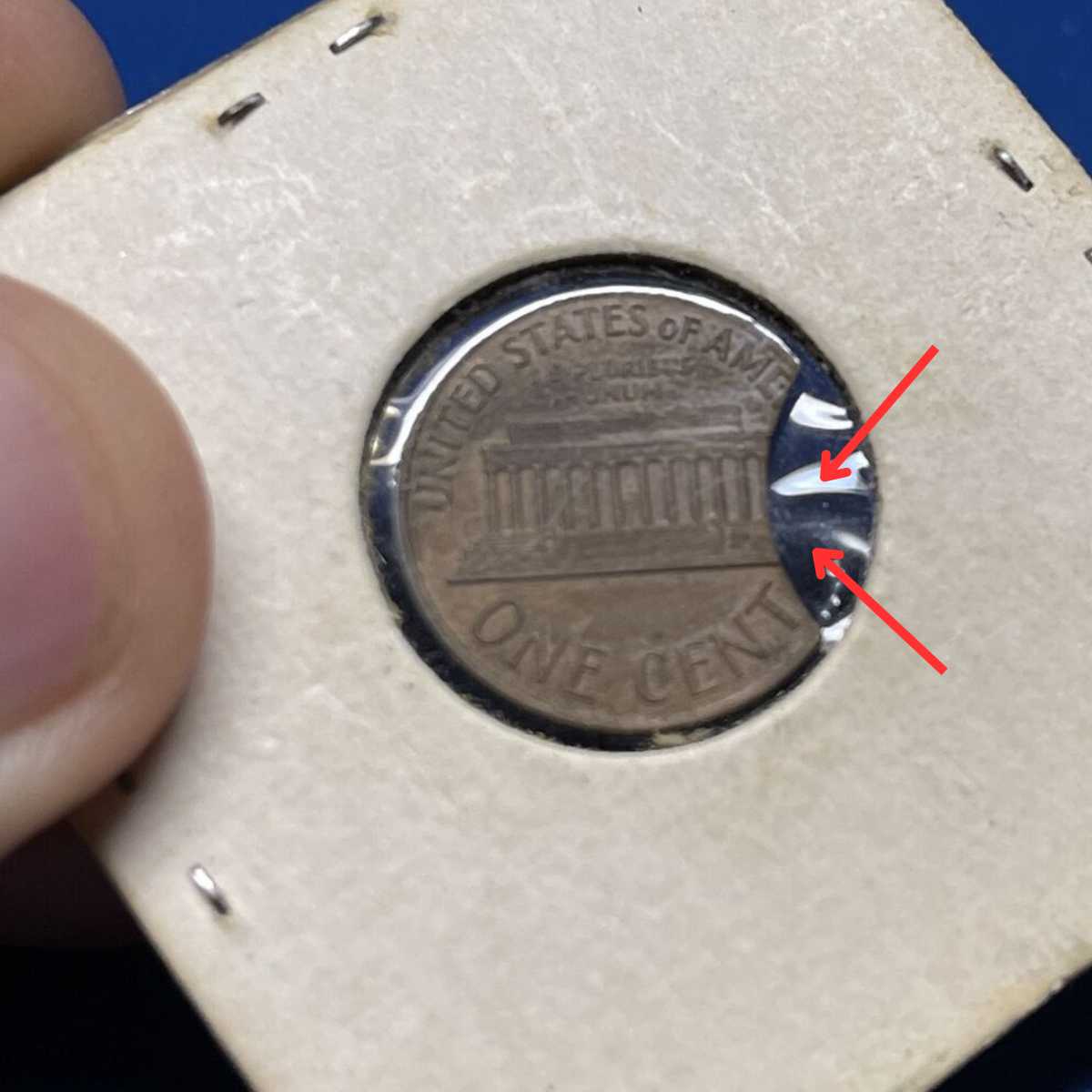
Clipped planchets are the result of improper cutting of the metal sheets. While clipped planchets are separated from regular planchets, a few (like this coin) slip through the cracks and end up as struck coins. This particular penny has an elliptical clip on the right side of the obverse.
1967 Penny: Is it Worth Collecting?
The 1967 Penny fits the bill for many kinds of collectors. To the beginner, the coin is very attainable while remaining dirt cheap. You can buy a box of pennies and end up with a bunch of 1967 Lincoln Pennies. However, you’ll have to compromise on the quality of the coins you get.
But if you’re an intermediate collector looking to upgrade an old collection, you can still buy mint condition 1967 Pennies at next to nothing.
Variety collectors may not have a lot of options, but they will still find the Special Mint Set of the 1967 Penny exciting.
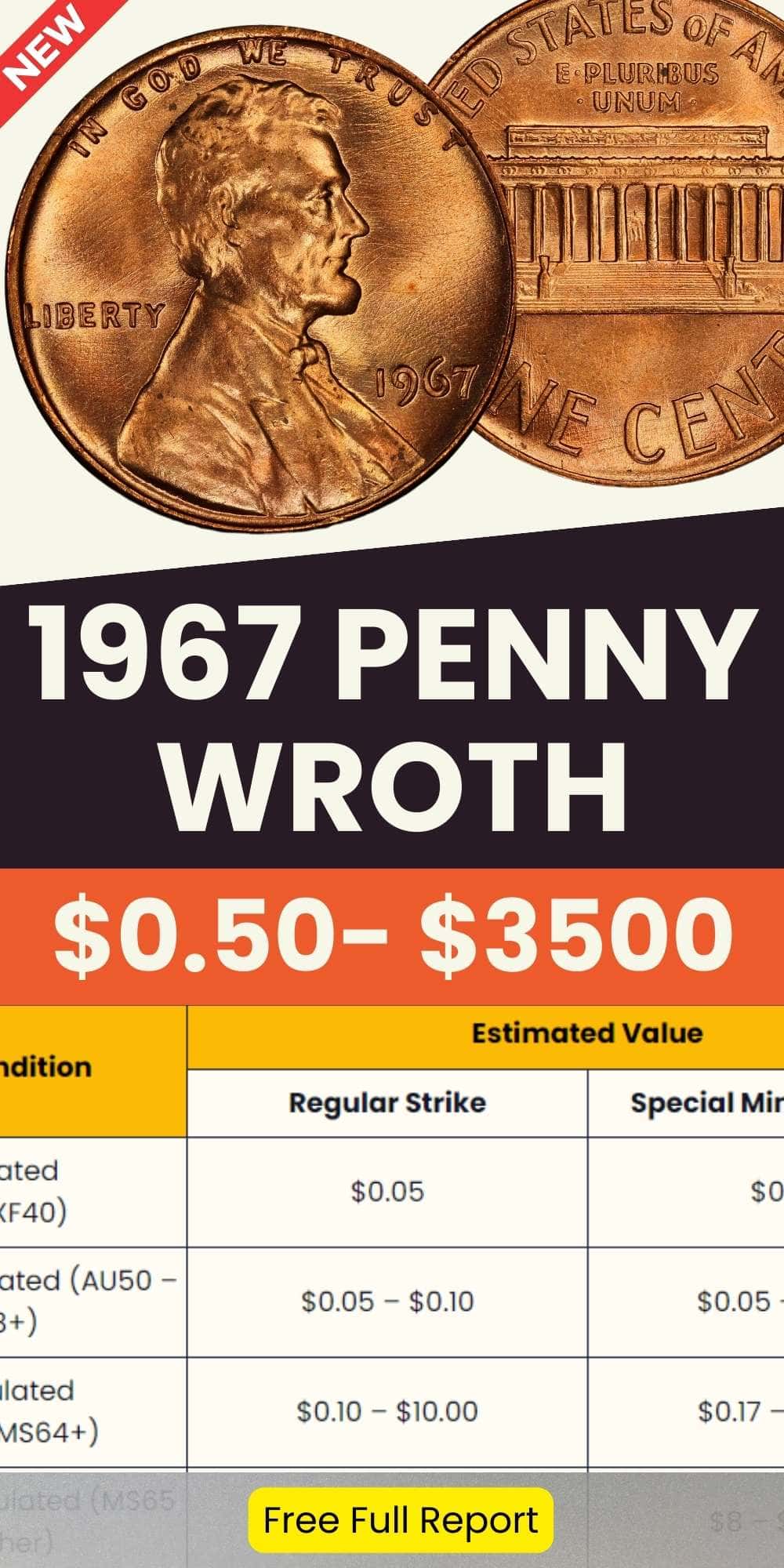

Jenson is a professional numismatist, a dedicated coin collector, a graduate of the College of Business at Oregon State, a life member of the American Numismatic Association (ANA), and an overall coin nerd. He is the founder of Coin Value List.
